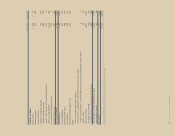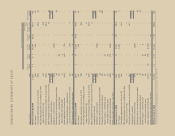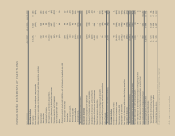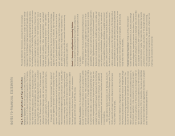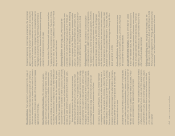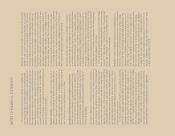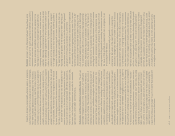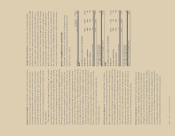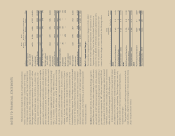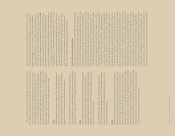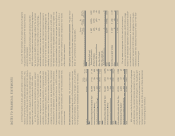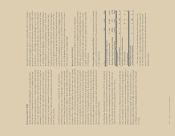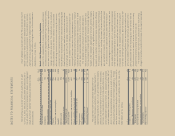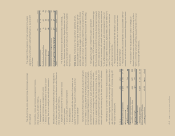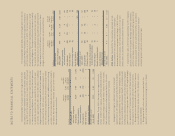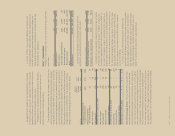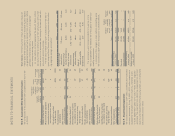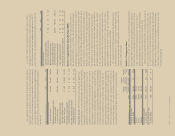Sara Lee 2011 Annual Report Download - page 91
Download and view the complete annual report
Please find page 91 of the 2011 Sara Lee annual report below. You can navigate through the pages in the report by either clicking on the pages listed below, or by using the keyword search tool below to find specific information within the annual report.
Variable Interest Entities The corporation consolidates variable
interest entities (“VIEs”) of which it is the primary beneficiary. Legal
entities with which the corporation becomes involved are assessed
to determine whether such entities are VIEs and, if so, whether or
not the corporation is the primary beneficiary. In general, the corpora-
tion determines whether it is the primary beneficiary of a VIE through
a qualitative analysis of risk, which identifies which variable interest
holder absorbs the majority of the financial risk or rewards and vari-
ability of the VIE. In performing this analysis, we consider all relevant
facts and circumstances, including: the design and activities of the
VIE, terms of VIE contracts, identification of other variable interest
holders, our explicit arrangements and our implicit variable interests.
Note 3 – Intangible Assets and Goodwill
The primary components of the corporation’s intangible assets
reported in continuing operations and the related amortization
expense are as follows:
Accumulated Net Book
In millions Gross Amortization Value
2011
Intangible assets subject to amortization
Trademarks $231 $104 $127
Customer relationships 142 106 36
Computer software 411 313 98
Other contractual agreements 1055
$794 $528 $266
Trademarks and brand names
not subject to amortization 56
Net book value of intangible assets $322
2010
Intangible assets subject to amortization
Trademarks $160 $÷81 $÷79
Customer relationships 100 87 13
Computer software 352 258 94
Other contractual agreements 541
$617 $430 187
Trademarks and brand names
not subject to amortization 54
Net book value of intangible assets $241
Financial Instruments The corporation uses financial instruments,
including forward exchange, options, futures and swap contracts,
to manage its exposures to movements in interest rates, foreign
exchange rates and commodity prices. The use of these financial
instruments modifies the exposure of these risks with the intent
to reduce the risk or cost to the corporation. The corporation does
not use derivatives for trading purposes and is not a party to lever-
aged derivatives.
The corporation uses either hedge accounting or mark-to-market
accounting for its derivative instruments. Under hedge accounting,
the corporation formally documents its hedge relationships, including
identification of the hedging instruments and the hedged items, as
well as its risk management objectives and strategies for undertaking
the hedge transaction. This process includes linking derivatives
that are designated as hedges of specific assets, liabilities, firm
commitments or forecasted transactions. The corporation also for-
mally assesses, both at inception and at least quarterly thereafter,
whether the derivatives that are used in hedging transactions are
highly effective in offsetting changes in either the fair value or cash
flows of the hedged item. If it is determined that a derivative ceases
to be a highly effective hedge, or if the anticipated transaction is no
longer likely to occur, the corporation discontinues hedge accounting
and any deferred gains or losses are recorded in the “Selling, general
and administrative expenses” line in the Consolidated Statements
of Income. Derivatives are recorded in the Consolidated Balance
Sheets at fair value in other assets and other liabilities. For more
information about accounting for derivatives see Note 15,
“Financial Instruments.”
Self-Insurance Reserves The corporation purchases third-party
insurance for workers’ compensation, automobile and product and
general liability claims that exceed a certain level. The corporation
is responsible for the payment of claims under these insured limits.
The undiscounted obligation associated with these claims is accrued
based on estimates obtained from consulting actuaries. Historical
loss development factors are utilized to project the future develop-
ment of incurred losses, and these amounts are adjusted based
upon actual claim experience and settlements. Accrued reserves,
excluding any amounts covered by insurance, were $86 million as
of July 2, 2011 and $76 million as of July 3, 2010.
Business Acquisitions With respect to business acquisitions, the
corporation is required to recognize and measure the identifiable
assets acquired, liabilities assumed, contractual contingencies,
contingent consideration and any noncontrolling interest in an
acquired business at fair value on the acquisition date. In addition,
the accounting guidance also requires expensing acquisition costs
when incurred, restructuring costs in periods subsequent to the
acquisition date, and any adjustments to deferred tax asset valua-
tion allowances and acquired uncertain tax positions after the
measurement period to be reflected in income tax expense.
88/89 Sara Lee Corporation and Subsidiaries




